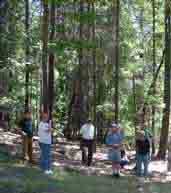
Approach
Members of forest communities offer not only their organizational capacity, permanence and local knowledge, but also their unique perspectives as both forest workers and the people who must live with the consequences of forest management. For these reasons, community-based organizations, such as WRTC, have made good partners with government agencies in managing forest lands. Some forest communities may require government help to build their assets and capacity so that they may become partners in the future. The WRTC is a model of how that can be done.
Investments in human, physical, financial and social capital can help to develop lively-hoods that restore natural capital. Growing a community-based industry that stewards and enriches forest lands takes time. Despite the numerous activities of the WRTC and its partners, Hayfork residents are still struggling. The staff of the WRTC realize that forest-based livelihoods will not solve all the economic and social problems of towns such as Hayfork. This approach, however, can be a viable form of economic development because it builds on the existing talents and resources found in forest communities.
Our program areas include:
- Forest stewardship
- Economic development
- On-the-job training
- Youth development
- Socio-economic research
- Affordable housing development
- Policy advocacy